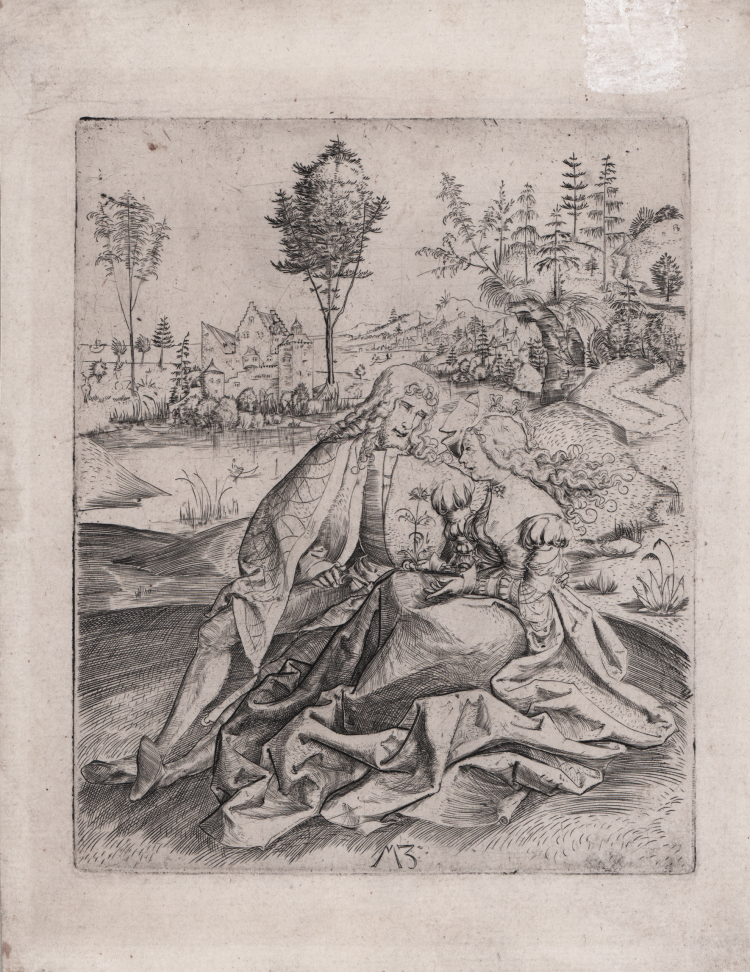




| Reference: | S5272 |
| Author | Martin ZASINGER (Maestro MZ) |
| Year: | 1500 ca. |
| Measures: | 130 x 155 mm |



| Reference: | S5272 |
| Author | Martin ZASINGER (Maestro MZ) |
| Year: | 1500 ca. |
| Measures: | 130 x 155 mm |
Engraving, circa 1500, signed at lower center with the monogram “MZ”.
"The composition of this print, which was an unusually popular one, recalls in a general way the influence of such early Dürer engravings as the Ill-Assorted Couple (TIB 10,93), but has its own unified and luminous landscape and an iconography of true, rather than mercenary, love. The young lady holds a carnation, a traditional betrothal flower in her right hand, and the couple gaze tenderly at one another.
Despite the assurance with which the landscape has been handled, the awkwardness of the drapery folds suggests that this is still a relatively early work. Mojzer has suggested a date of 1500 and also sees the influence of Dürer's The Promenade and of his Self-Portrait of 1498 in Madrid.
Lehrs knew seventy impressions, of which more thn twenty were on early paper, but only three were considered to be of prime quality." J. Hutchison in TIB 9,14.015
|
Bartsch VI.379.16; Nagler 16; Lehrs 1908-34 VIII.364.15;
TIB 0914.015.
|
Martin ZASINGER (Maestro MZ) (Monaco 1477 - 1509?)
|
The identification of the monogrammist MZ with the Munich goldsmith, Matthäus Zaisinger, or Zasinger, first mentioned in the seventeenth century, has been widely, but not universally, accepted. The name of Matthäus Zaisinger or Zazinger is connected to the prints of Master MZ from very early, in the list of his prints made by the Nuremberg collector Paul Behaim in 1618, which survives. Behaim calls Master MZ "Matheus Zaszinger" or "Zingel", without giving any reasons. Joachim von Sandrart included MZ in his Teutsche Academie of 1675, suggesting the initials stood for Martin Zink, Zatzinger or Zasinger. A Matthäus Zagel has also been introduced to the debate. Subsequently, records of Matthäus Zaisinger (or Zaysinger) in Munich have been unearthed by scholars. These cover such a long period (active 1498-1555 as printer, goldsmith & mint official) that there are probably two of them, presumably father and son. The earlier is often identified with Master MZ, but this remains speculative. A surviving engraved piece of metalwork, the back of a reliquary dated 1501, is thought to be by Zaisinger. Twenty-two engravings are accepted as Master MZ works. Master MZ is one of the earliest and most original engravers to have been influenced by the prints of the young Albrecht Dürer.
|
|
Bartsch VI.379.16; Nagler 16; Lehrs 1908-34 VIII.364.15;
TIB 0914.015.
|
Martin ZASINGER (Maestro MZ) (Monaco 1477 - 1509?)
|
The identification of the monogrammist MZ with the Munich goldsmith, Matthäus Zaisinger, or Zasinger, first mentioned in the seventeenth century, has been widely, but not universally, accepted. The name of Matthäus Zaisinger or Zazinger is connected to the prints of Master MZ from very early, in the list of his prints made by the Nuremberg collector Paul Behaim in 1618, which survives. Behaim calls Master MZ "Matheus Zaszinger" or "Zingel", without giving any reasons. Joachim von Sandrart included MZ in his Teutsche Academie of 1675, suggesting the initials stood for Martin Zink, Zatzinger or Zasinger. A Matthäus Zagel has also been introduced to the debate. Subsequently, records of Matthäus Zaisinger (or Zaysinger) in Munich have been unearthed by scholars. These cover such a long period (active 1498-1555 as printer, goldsmith & mint official) that there are probably two of them, presumably father and son. The earlier is often identified with Master MZ, but this remains speculative. A surviving engraved piece of metalwork, the back of a reliquary dated 1501, is thought to be by Zaisinger. Twenty-two engravings are accepted as Master MZ works. Master MZ is one of the earliest and most original engravers to have been influenced by the prints of the young Albrecht Dürer.
|